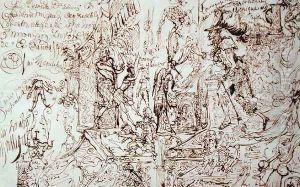Jean-Martin Charcot Paintings
Jean-Martin Charcot was a pioneering French neurologist rather than an artist, born on November 29, 1825, in Paris, France. Although not an artist in the traditional sense, Charcot's work had a profound impact on both the medical field and the art world, as his studies influenced a myriad of artists and thinkers, including the famous Surrealist movement.
Charcot is best known for his work on hypnosis and hysteria. He became a professor at the University of Paris in 1872, where he taught many future prominent medical professionals. Charcot was a leading physician at the Salpêtrière Hospital in Paris, where he conducted research on diseases of the nervous system, particularly hysteria and epilepsy. His work was characterized by careful clinical observation and rigorous documentation, including extensive use of photography, which was a relatively new technology at the time. This visual representation of his patients can be seen as an intersection between medicine and art.
Throughout his career, Charcot developed several innovative diagnostic techniques. He was the first to describe and name multiple sclerosis and was instrumental in understanding Parkinson's disease, even lending his name to one of its symptoms, 'Charcot's joint.' He also explored other neurological conditions, such as amyotrophic lateral sclerosis (ALS), which is sometimes referred to as Charcot's disease.
Charcot's work extended beyond neurology into the realms of psychology and art. He was a teacher to Sigmund Freud, who would later develop psychoanalysis. Charcot's method of using hypnosis as therapy influenced not only medicine but also artists interested in the subconscious and dream states. His lectures, complete with dramatic demonstrations of hypnosis on patients, were attended by artists, writers, and intellectuals of the day. His influence can be seen in the works of André Brouillet, who painted 'A Clinical Lesson at the Salpêtrière,' capturing Charcot in the lecture hall.
Charcot's legacy is complex; while he advanced the understanding of neurological disorders, some of his theories on hysteria were later discredited. However, his insistence on the importance of the visual in medical diagnosis and his open-minded approach to psychological conditions had a lasting impact on both science and art.
Jean-Martin Charcot passed away on August 16, 1893, in Morvan, France. His contributions to neurology are still recognized today, and his life's work bridged the gap between medicine and the humanities, influencing how we understand the human mind and its depiction in art.
